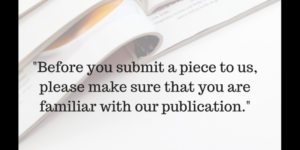Communications Director
 Many of us are freelancing these days — which means we’re looking for leads, reading submission guidelines, and pitching stories to new publications on a regular basis.
Many of us are freelancing these days — which means we’re looking for leads, reading submission guidelines, and pitching stories to new publications on a regular basis.Ideally, every publication would have clear writer’s guidelines that include the managing editor’s name, contact, columns accepting submissions, and desired word count. However, most writer’s guidelines include some variation of the following statement I pulled from Rethinking Schools Magazine:
“Before you submit a piece to us, please make sure that you are familiar with our publication.”
That’s a pretty vague statement. What does that mean? What are you supposed to pay attention to when studying these publications? Whether you’re targeting an online publication, a glossy New York magazine, a regional publication, or a special-interest magazine for your pitch, there are a couple of key things you should study in every publication.
The Masthead Is Your Friend
The masthead is the section of the publication usually up front that tells you the names of the publisher, editor, and sometimes the contributors. For online publications, you’ll want to find the “about” page or “staff” page. Sometimes the site has a tab in the menu and sometimes it’s buried in all the extra company links at the bottom of each page.
The masthead is invaluable because not only do you want to address your query to a name (no generic salutations will do) you’ll also want to cross-check the names in the masthead with the articles written. This tells you who writes what. Once you know what the staffers write, then you’ll have a better idea of what articles are open for freelance submissions.
If you’re researching a paper publication, you’ll want to camp out in the periodicals section of the library (if you’re a subscriber and have a stash, better yet). Go through at least the last six months worth of issues. A year is better.
If you’re researching an online publication, simply plug the staff writers’ names into the search bar and take note on what they’re writing.
-
What do they publish?
-
What are the regular departments of the publication?
-
What have they covered in the past year?
-
What topics do they always cover? These are called “evergreens.” For example, women’s magazines are constantly covering different approaches to weight loss and sex.
Read Bylines and Bios
Once you’ve identified what a publication tends to accept from freelancers, read the bylines and bios. You’ll want to understand:
-
Who is writing these articles?
-
Does their bio look similar to yours?
-
Is the publication looking for credentials beyond “writer”? A specialist in their field, or a celebrity, perhaps?
-
Or are most bios from other freelancers/writers?
With this research done you’re better positioned to query and discuss article ideas with the editor of a publication.
***
 Bonnie Jean Feldkamp is a blogger and features contributor for Cincinnati Family Magazine. Her essays have published in the New York Times; Brain, Child Magazine; Scary Mommy; as well as regional parenting publications in North America
Bonnie Jean Feldkamp is a blogger and features contributor for Cincinnati Family Magazine. Her essays have published in the New York Times; Brain, Child Magazine; Scary Mommy; as well as regional parenting publications in North America

2 comments for “Back to Basics: How to Research a Publication Prior to Pitching”